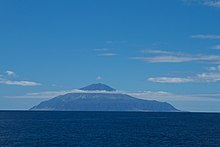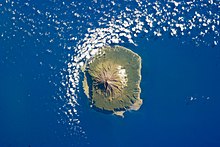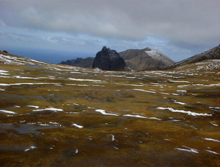Tristan de Acuna
Tristan da Cunha (in English, Tristan da Cunha; in Portuguese, Tristão da Cunha) is a British archipelago made up of several islands (the largest, with the same name, and the uninhabited Inaccessible and Ruiseñor) in the South Atlantic. Together with the island of Diego Álvarez, the entire territory is constituted as a dependency of the island of Santa Elena, the closest inhabited place, located 2173 km to the north. Access to the main island is tremendously complicated, due to its remoteness and the fact that it is surrounded by cliffs over 600 meters high. Tristán de Acuña is the most remote inhabited place (that is, the furthest from any other inhabited place) on Earth; the island has a population of less than 270 people and as such is listed in the Guinness Book of Records.
History
Discovered in 1506 by the Portuguese navigator who gave it its name, Tristão da Cunha, it began to be permanently inhabited at the beginning of the century XIX, when it was annexed by the British Crown in 1816. At that time, the British did not want the archipelago to be used by the French as a base to try to carry out a rescue operation for Napoleon, confined in the Helena Island. Since then it has maintained a stable population of about 280 in its settlement of Edinburgh of the Seven Seas, named after the visit of Prince Alfred, Duke of Edinburgh, in 1867, on his return to the world.
In the 17th and 18th centuries, the French and Dutch governments, as well as the British East India Company, considered taking possession of the island, but gave up as it had no suitable docking areas. The island was later used as a temporary base for whalers and sealers, mainly from the United States. It was from there that the first settlers arrived at the beginning of the 19th century. In 1876, the British government formally declared it part of the British Empire and in 1938 the island was considered a dependency of the island of Saint Helena.
In 1961, a volcanic eruption caused the evacuation of the population to the United Kingdom, to the town of Calshot. There they had to endure one of the worst British winters and new diseases for which they were not prepared. Some of the older ones died and others stayed, but most returned in 1963. Upon reaching their homes, they found that the main settlement on the island had been affected by the eruption, and that some looting had taken place by pirates.. The domestic dogs, left to their own devices, had hunted down all the sheep.
An extratropical cyclone hit the island on May 21, 2001, causing partial damage and ripping off some roofs. In February 2008 there was a fire in the fish factory, which had a great economic impact. In November 2011 the boat Puma's Mar Mostro, of the Volvo Ocean Race, reached the island after breaking its mast in the first stage between Alicante and Cape Town. This event brought the archipelago out of anonymity in the international press.
She was quoted, among others, in The Narrative of Arthur Gordon Pym, by Edgar Allan Poe; in Jules Verne's A Fifteen-Year-Old Captain, the first time they see land at the end of their long voyage; in The Sphinx of the Ice; and in The Children of Captain Grant, by the same author, where the second chapter of the second volume is dedicated to him; not without forgetting a mention in The Mysterious Island, linked to the aforementioned novel. Several chapters of the novel The King of the Air, by Emilio Salgari, take place on the Inaccessible islet, which belongs to the archipelago.
Geography
Tristán de Acuña is located at the coordinates (37°06′S 12°16′W / -37.100, -12.267) 37º06' south latitude, 12º16' west longitude in the middle of the South Atlantic, 3,360 km from South America and 2,816 km from South Africa. The nearest inhabited territory is another island, Saint Helena, 2,161 km to the north. The main island, about 98 km², has a very mountainous relief due to its volcanic origin, but there is a flat area on the northwest coast, called The Hillpiece, where Edinburgh of the Seven Seas is located.. The highest peak is Queen Mary Peak, a 2,062 m high volcano, which is located in the center of the main island and is covered by snow during winter. It is also the highest mountain in the South Atlantic. The climate is of the subtropical marine type, with small temperature changes between winter and summer. The Inaccessible Island (10 km²) and the Nightingale Island (2 km²) are located 35 km southwest of Tristán de Acuña, while Gough Island (also known in Spanish as Diego Álvarez Island) is further away, about 395 km southeast of Tristan. 40% of the territory of the archipelago is protected as a nature reserve and some of the islets are declared World Heritage Sites. The archipelago is part of an ecoregion called Prairie and Scrub of Tristán de Acuña and Diego Álvarez Islands.
Climate
The archipelago has a humid climate. The Koppen system classifies it with temperate temperatures. Sunlight is quite limited due to persistent westerly winds. By the "Trewartha" classification, Tristán de Cuna has a humid subtropical climate. The number of rainy days is comparable to that of the Aleutian Islands.
| Month | Ene. | Feb. | Mar. | Open up. | May. | Jun. | Jul. | Ago. | Sep. | Oct. | Nov. | Dec. | Annual |
|---|---|---|---|---|---|---|---|---|---|---|---|---|---|
| Temp. max. abs. (°C) | 23.7 | 24.4 | 24.4 | 22.4 | 20.3 | 18.7 | 17.8 | 17.3 | 17.1 | 18.4 | 22.4 | 21.8 | 24.4 |
| Average temperature (°C) | 20.4 | 21.2 | 20.5 | 18.9 | 16.9 | 15.3 | 14.4 | 14.2 | 14.3 | 15.4 | 17.0 | 18.9 | 17.3 |
| Average temperature (°C) | 17.9 | 18.8 | 17.9 | 15.4 | 14.6 | 13.1 | 12.2 | 11.9 | 12.0 | 13.0 | 14.6 | 16.5 | 14.8 |
| Temp. medium (°C) | 15.4 | 16.2 | 15.3 | 12.3 | 11.9 | 10.9 | 10.0 | 9.6 | 9.7 | 10.6 | 12.2 | 14.1 | 12.4 |
| Temp. min. abs. (°C) | 10.9 | 11.8 | 10.3 | 9.5 | 7.4 | 6.3 | 4.8 | 4.6 | 5.1 | 6.4 | 8.3 | 9.7 | 4.6 |
| Rains (mm) | 93 | 113 | 121 | 129 | 155 | 160 | 160 | 175 | 169 | 151 | 128 | 127 | 1681 |
| Days of rain (≥ 1 mm) | 18 | 17 | 17 | 20 | 23 | 23 | 25 | 26 | 24 | 22 | 18 | 19 | 252 |
| Hours of sun | 139.5 | 144.0 | 145.7 | 129.0 | 108.5 | 99.0 | 105.4 | 105.4 | 120.0 | 133.3 | 138.0 | 130.2 | 1498 |
| Relative humidity (%) | 79 | 77 | 75 | 78 | 78 | 79 | 79 | 79 | 78 | 79 | 79 | 80 | 78.3 |
| Source #1: Worldwide Bioclimatic Classification System | |||||||||||||
| Source No. 2: Climate and Temperature. | |||||||||||||
Demographics
The special demographic characteristics of its inhabitants, due to their isolation and high inbreeding, make studying the island's population very interesting. Although some young people from Tristán de Acuña leave the island in search of couple, marriages between the inhabitants themselves are the rule, and mean that there are only eight different surnames on the island: Glass, Green, Hagan, Laverello, Repetto, Rogers, Swain and Patterson, divided into eighty families, which has led to a genetic profile with a higher frequency of certain pathologies, such as asthma and glaucoma. However, other diseases common in the rest of the world, such as colds, do not exist except as a result of a visit from a ship. A fairly large number of bottles of whiskey are consumed on the island. In 1993 and 1994, each individual drank the equivalent of almost fifty liters of whiskey on average per year.
There is currently a grocery store, a local radio station, a cafe (The Cafe of Tristan), a pub (The Albatros Bar) in the Edinburgh of the Seven Seas settlement ), a video store, a soccer field, a golf field, a swimming pool and a tennis court. The inhabitants also own a community meeting center. Connection to the outside world is maintained via a satellite telephone/fax, located in the administrator's office, but the Internet connection is recently being improved. There is no airport and the port can only be reached by boat. The annual arrival of the ship RMS Saint Helena brings with it new products such as medicines, books, videos, magazines and mail. There is also a farm in Sandy Point, which was inhabited temporarily in the fifties and eighties, when it was necessary to cover a demand for wood and different types of fruit that could not be obtained in other places on the island, since in this This area, further east, enjoys a warmer climate. For the most complicated health emergencies, the sick are transferred to a hospital in Cape Town, although family doctors, dentists and other specialists make long stays for days to check the health of the population.
Language
Tristán de Acuña's isolation has led to the development of its own dialect of English. In popular writing, he has been described by writer Simon Winchester as "a sonorous amalgamation of 19th-century home counties and idiom, Afrikaans slang and Italian."
Religion
The main religion among its population is Christianity, and the only major denominations in the region are the Anglican Church and the Catholic Church. The island's Catholic population is served by the Sui Iuris Mission of Santa Elena, Ascension Island and Tristán de Acuña, which administers the Apostolic Prefecture of the Malvinas Islands.
Government and politics
There are no political parties or unions in Tristán de Acuña. Executive power rests with the King, who is represented in the territory by the Governor of Saint Helena. Since the Governor permanently resides in Saint Helena, an administrator is appointed to represent him on the islands. The Administrator is a career Foreign Office civil servant, selected by London, who acts as head of local government and receives advice from the Tristan de Cuna Island Council. Since 1998, each Administrator has served a three-year term (beginning in September, upon arrival of the supply ship from Cape Town). Sean Burns began a second term as Trustee in November 2016.
The Administrator and the Island Council work from the Government Building, which is the only two-story building on the island. The building is sometimes referred to as "Whitehall" or "H'admin Building" and in it are the Office of the Administrator, the Treasury Department, the administration offices and the Council Chamber, where the meetings of the Island Council are held. Police work is carried out by a full-time police inspector and three special constables. Tristán de Acuña has some legislation of its own, but the law of Santa Elena applies generally to the extent that it is not inconsistent with local law, as long as it is appropriate for local circumstances and subject to modifications that local circumstances may cause. make necessary.
Island Boss
The Island Council is made up of eight elected and three appointed members, who serve a three-year term beginning in February or March. A separate but simultaneous vote is held to elect the Island Chief, who is the political leader of the community. James Glass was elected to the position in March 2019, returning after sixteen years to begin a record fourth term in office.
Economy
The start of the lobster industry[citation needed] in 1950 allowed the existing impoverished economy to flourish from a subsistence to a market economy, although agriculture remains the main occupation of the islanders along with fishing. All the land is community property and the number of cattle is strictly controlled to preserve pastures and prevent families from having a better economic position than others. The purchase of land or the settlement of people from outside Tristán de Acuña is also not allowed. The sale of stamps, mainly to collectors, also brings in a considerable income.
Although it is a dependency of Saint Helena, the local currency of that island, the Saint Helena pound, is not used, but the same as in the United Kingdom, the pound sterling. Like most British Overseas Territories, it was never part of the European Union, but was instead a member of the Association of European Union Overseas Countries and Territories.
Culture
Media
Local television began in 1984 using recorded programming on Tuesday, Thursday and Sunday nights. Live television did not reach the island until 2001, with the introduction of the British Forces Broadcasting Service, which now provides BBC One, BBC Two, Channel 4, ITV and BFBS Extra, broadcast to the islanders via local transmitters. Recently the service was upgraded to digital, most of the TV screens are modern while some old CRT equipment is still in use and there is at least one TV per house. BFBS Radio 2 is the local radio station available. The island's government and the Tristan de Cuna Association, which maintains it from the UK, maintain an official website. A community newsletter, called Village Voice, is produced each week.
Festivities
The island has an annual break from government and factory work that begins before Christmas and lasts three weeks. The beginning of the festival, called Rupture Day, is often marked with special events and celebrations.
Gallery
Contenido relacionado
Portuguese economy
Nihonshoki
Paleolithic

















